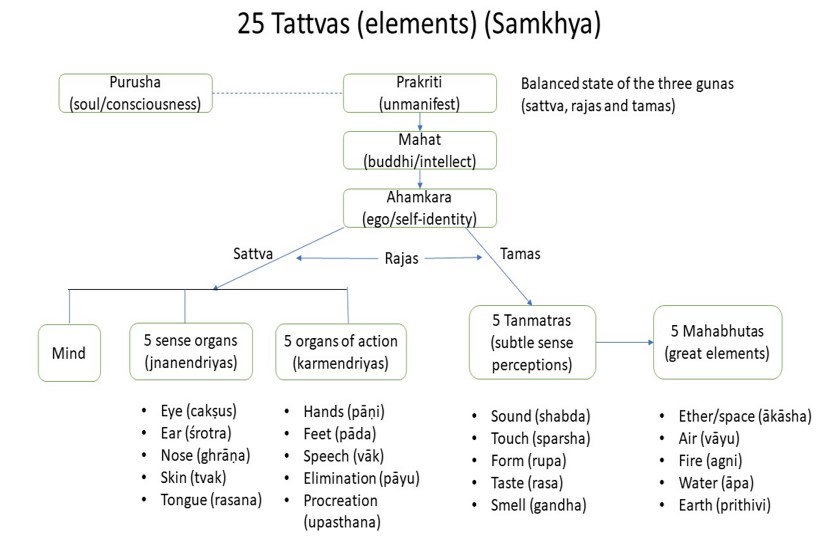सूक्ष्मविषयत्वं चालिङ्गपर्यवसानम्॥४५॥
sUkShmaviShayatvaM = the state of samadhi concerned with subtle objects; cha = and; ali~gga = last stage of the gunas (without a symbol); paryavasaanam = extending (up to)
Taimni
"The province of Samadhi concerned with subtle objects extends up to the Alinga stage of the three gunas"
Different objects are subtle to different degrees and the degrees of subtlety have been classified according to the stages of the gunas (as explained later in sutra 2.19). As per the Sankhya philosophy, all objects can be classified in four categories according to the four stages of the gunas. The last stage of the gunas is called "alinga" and hence that is the most subtle object of contemplation for samadhi.
Aranya
The subtle forms of various elements, called "tanmatra", are paired as follows: earth – smell; water – taste; fire – sight; air – touch; space – sound. Ahamkara (ego) is subtler than tanmatra, and buddhi (intellect) or Mahat-tattva is subtler than ego. The subtlest of them all is the unmanifest "prakriti". Purusha, even though subtle, cannot be considered in the same class since it is not the material cause but the efficient cause of the first element, intellect (buddhi).
The word "linga" means an indicator or a symbol for some object. A linga is an indicator of its cause and ultimately merges back into its cause. "Alinga", by contrast, has no cause to merge into and has no indicator or symbol. In this sutra, the unmanifest prakriti is termed as Alinga and represents a state of equilibrium of the three gunas – sattva, rajas and tamas.
The tanmatras – sense of smell, taste etc – are the subtle sensations of subtle objects received through the senses. Once received by the mind, they become the modifications in the mind (vrittis).
Discussion
It is perhaps worthwhile to recap here how the manifest phenomenal universe evolved from the unmanifest "moola prakriti". As per the Sankhya philosophy, Purusha and Prakriti are two independent entities, Purusha being the conscious principle whereas Prakriti is the inert creative force. Prakriti requires the presence of Purusha for the creation of the phenomenal world. In the unmanifest state, the three gunas – sattva, rajas and tamas – are in perfect equilibrium. When the equilibrium is disturbed, the process of evolution begins. The first element to evolve is Buddhi/Mahat (intellect). The process of evolution is depicted in the diagram below (borrowed from swamij.com).

Samkhya evolution – 25 elements
In different stages of samadhi – vitarka, vichara, ananda and asmita – one moves from gross to subtler elements. The most subtle element that can be used as an object of meditation is buddhi/mahat (pure intellect) which is a reflection of the pure I-sense (asmita). Vyasa, in his commentary, called Mahat as "linga-matra" which means "indicator only". All the other elements which are grosser than Asmita have been termed as "linga" as they indicate to something subtler which is also the cause of that gross element. For example, the tanmatras (sense of smell, touch etc) are subtle compared to earth, water etc but gross compared to "Ahamkara" (ego). In that sense a tanmatra is Linga as it indicates toward the Ego as its cause. Also, one can move from Linga to its cause and use that as an object for samadhi. Mahat, on the other hand, has been mentioned as "linga-matra" which means that even though it has a casue, "moola prakriti" in this case, one may not use that cause as an object of meditation.
Leave a Reply